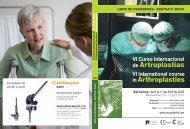cadera / hip - Active Congress.......
cadera / hip - Active Congress.......
cadera / hip - Active Congress.......
You also want an ePaper? Increase the reach of your titles
YUMPU automatically turns print PDFs into web optimized ePapers that Google loves.
MARTES / TUESDAY<br />
38<br />
lar component aseptic loosening<br />
- No component fracture or osteolysis<br />
- 9 Peripheral c<strong>hip</strong>s (2.6%) @ insertion<br />
D. Potential Advantages of Ceramic on<br />
Ceramic Bearings<br />
• Extremely low wear<br />
• In vitro volumetric wear<br />
• 0.01-0.05mm 3 /million cycles 61,152,157,199<br />
• In vivo linear wear<br />
• Retrieval wear rates as low as 0.016 mm/<br />
year - 0.025mm/year 50,88,101,124,198<br />
- 4000x less than historical metal on polyethylene<br />
THA<br />
• Increased wear seen with loose or vertical<br />
sockets, femoral neck/socket impingement,<br />
and poor quality alumnia 179,207<br />
• Bioinert<br />
• Usual reaction to ceramic particles is<br />
fi brocytic type with few macrophages and<br />
no giant cells 20,60,114,115<br />
• PGE2 determination revealed less infl ammatory<br />
mediators than metal on polyethylene<br />
180<br />
• Extreme Hardness<br />
• Alumnia 4X harder (2000 HV) than THA<br />
Cobalt-Chrome, Titanium, and Stainless<br />
Steel 85,181<br />
• Increased resistance to third body wear<br />
• High Wettability<br />
• Smaller wetting angle provides increased<br />
lubrication and decreased adhesive<br />
wear<br />
• Alumina has best wettability compared<br />
to all other bearing materials in clinical<br />
use 192<br />
• Larger Femoral Head Sizes<br />
• Improved ROM and <strong>hip</strong> stability associated<br />
with large heads without deleterious<br />
increases in wear particles<br />
E. Potential Disadvantages of Ceramic on<br />
Ceramic Bearings<br />
• Fracture<br />
• Range 0.01% to 0.4% in recent extensive<br />
reviews 64,78,81,179,185<br />
• Multifactorial<br />
• Material and design features of the ce-<br />
ramic head<br />
• Taper junction of femoral component<br />
• Application technique of surgeon<br />
• Patient-related factors (activity level,<br />
etc.)<br />
• 2 Zirconia head fractures out of 300,000<br />
implanted 161<br />
• Revision<br />
• Should not apply new ceramic component<br />
to a “used” trunion or liner locking<br />
system<br />
• Use alternative bearing material or revise<br />
stem and / or liner<br />
• Ceramic fragments can cause extensive<br />
third body wear 103<br />
• Technique sensitive<br />
• Reduced range of acceptable acetabular<br />
and femoral component positioning to<br />
avoid impingement and edge loading 207<br />
• Implant costs<br />
• Ceramic heads > 2x more expensive than<br />
Cobalt- Chrome (i.e. $400 vs. $900) 189<br />
IV. Improved Polyethylene (Highly Crosslinked)<br />
A. History<br />
• Sir John Charnley implants fi rst total <strong>hip</strong><br />
with metal on polyethylene bearing surface<br />
in 196231 • Well designed <strong>hip</strong> replacements with a<br />
metal on polyethylene bearing demonstrate<br />
low wear rates and good long-term<br />
clinical results35 • Expansion of indications for THA in<br />
younger and more active patients reveals<br />
limitations of conventional polyethylene as<br />
a bearing surface material<br />
• Polyethylene wear identifi ed as the primary<br />
cause of osteolysis and often the ultimate<br />
7, 86,<br />
cause of failure of many implants<br />
124,125,174,175<br />
• Alternative bearing materials against polyethylene<br />
to decrease wear investigated<br />
• Ion implanting and other surface hardening<br />
techniques to cobalt-chromium and<br />
titanium alloy femoral heads are reported<br />
to both decrease and increase wear of op-





